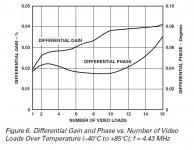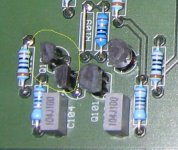John, forgive me jumping in here.
Maybe you would have got an 'A' on the JC3 IF the reviewer and others in the industry did not know you had used an op-amp! Remember that ML with the AD797 that got an 'A' rating . . .
😀
ok - I know I am going to get flamed. I'm outa here!
Maybe you would have got an 'A' on the JC3 IF the reviewer and others in the industry did not know you had used an op-amp! Remember that ML with the AD797 that got an 'A' rating . . .
😀
ok - I know I am going to get flamed. I'm outa here!
Maybe, but I would not bet on it. I can only relate what I have experienced. In truth, my Vendetta Research phono stage is so much better than the JC-3, that there is little comparison. Of course, I own one.
I have a hypothesis, FWIW - undegenerated bipolar inputs.
I agree - one of possible reasons.
He also measured the AD797. It came out pretty good in differential phase.
I would respectfully comment that I do not assume the differential phase to be the reason of well subjectively accepted opamp.
This phono preamp situation reminds me of my position with my Porsche 944. I love my 944, BUT it is not that fast, just spunky. IF I had a 911 or one of its successors, perhaps I would put the 944 in the 'proper' perspective, a design made partly of VW parts, and many design compromises. BUT I don't have access to a 911, or a Boxter, AND I will never be able to afford one, so I am relatively happy with what I have, AND by comparison to the vast majority of autos out there, within my cost range, the Porsche 944 is the finest car I have ever owned.
I am sure that many customers for the JC-3 will be very happy with how it sounds, and its obvious advantages over many other, especially cheaper products.
I do not expect the customer for the JC-3 to be a newbie, but someone with some experience with other phono stages, yet not the very best, just like I am with sports cars, as the 944 is my 4th sports car that I have driven for at least 5 years. The others were fun, but they did have their limitations that I hardly noticed when I owned them.
Audio is much the same, in my opinion.
I am sure that many customers for the JC-3 will be very happy with how it sounds, and its obvious advantages over many other, especially cheaper products.
I do not expect the customer for the JC-3 to be a newbie, but someone with some experience with other phono stages, yet not the very best, just like I am with sports cars, as the 944 is my 4th sports car that I have driven for at least 5 years. The others were fun, but they did have their limitations that I hardly noticed when I owned them.
Audio is much the same, in my opinion.
There were also publications about the differential phase shifts in interconnect cables
Current Dependent Phase Shifts in Audio Cables?
After simple analysis, the results were finally explained simply by L parameter (cable inductance effects). Audiphiles know, that simply low inductance does not automatically made cable good.
Current Dependent Phase Shifts in Audio Cables?
After simple analysis, the results were finally explained simply by L parameter (cable inductance effects). Audiphiles know, that simply low inductance does not automatically made cable good.
I have just read the Stereophile review of the JC 3. It is a very nicely built and very well measuring phono preamp, congratulations.
Time after time my customers ask me (I would rather say require) a phono preamp based on discrete components only, with JFET input as a must. I am still hesitating, though I have a design prepared in electrical drawings. It would be rather costly and I am not sure if my necessary expenditures would return in a sale of several pieces.
Time after time my customers ask me (I would rather say require) a phono preamp based on discrete components only, with JFET input as a must. I am still hesitating, though I have a design prepared in electrical drawings. It would be rather costly and I am not sure if my necessary expenditures would return in a sale of several pieces.
Time after time my customers ask me (I would rather say require) a phono preamp based on discrete components only, with JFET input as a must.
Curious to know what's behind this request. Is it that they are unable to hear good sound when they know there's no JFET input stage in their phone pre? Otherwise the choice of input device is an engineering decision, to get the best sound at a particular price-point. Seems like your customers have a fashion request for JFETs, just as I used to prefer AMD 'Inside' rather than Intel.
Based on my experience with line level preamplifiers, the best sonic results I have achieved (even for me) are with JFET input, discrete, complementary symmetrical designs. So I am with John here. If the similar topology was with BJT input stage, the customers would always prefer the JFET version, even if they owned both of them. I do not want to turn any spirals again. To me, the JFET input stage is better sounding than the bipolar, even if they measure almost same. My explanation is the higher EMI immunity, though I may be wrong. Anyway, I will continue with the circuits that have proven well sonic accepted.
Regarding opamps, it is easy to make swap tests. You do not to and you would not like to inform the listener which opamp is tested. Despite this fact they can easily tell the differences, if they are experienced and trained listeners.
Regarding opamps, it is easy to make swap tests. You do not to and you would not like to inform the listener which opamp is tested. Despite this fact they can easily tell the differences, if they are experienced and trained listeners.
I will be showing a new design at CES in 6 weeks, using complementary jfets, etc. for Constellation Audio. An even more adventurous design is also in the works, but is not finished.
So then its not primarily about JFETs, its about getting the best sound. That so far has necessitated JFETs. Thanks for the clarification. I agree with you about the probable cause being better EMI immunity btw.
Bump
I'm too very interested.
No, he didn't. Audiophile lore pumped up by Fremer. When you have 5 trials, 100 participants, and someone doesn't turn in his score sheet, what you have is hype, not results.[...]
Might be, but it was 5 trial dbt, Fremer did turn in his score sheet (John Atkinson did as well), and Fremer correctly identified the amplifier playing 4 times out of 5. So you got Fremer correct 5 times out of 5 on the same/difference question, correct 4 times out of 5 for the question which amplifier (out of 3 possible) was playing. Atkinson and Fremer as a tag team were correct 9 times out of 10 for the same/difference question.
I don´t know if there were 100 participants overall, but it was reported that no other attendee of the AES-convention, who took the test reached a significant result.
Care to calculate the probabilities that Fremer was just guessing and that Fremer and Atkinson as a tag team were just guessing?[...]
No, it's still incorrect. As is your recounting of the Fremer incident.
[...]
Please remember to quote the source which corrects Fremers description of the amplifer-DBT; i am very interested, because normally Clark, Nousaine or Krueger commented on every such statement (especially if untrue), but i can´t remember any rebuttal.
I'm too very interested.
I will be showing a new design at CES in 6 weeks, using complementary jfets, etc. for Constellation Audio. An even more adventurous design is also in the works, but is not finished.
John after doing some research yesterday I noticed that virtually all discrete JFET's are on last time buy even Fairchild's J3xx series. We will all be left with Interfet, Linear Systems, and any other garage fabs that make obsolete parts. I hear there is lots of money in making old TTL gates.
BTW is there anything wrong with the 2SJ107? It seems still available cheaply and looks a lot like the SJ74.
Yes, Joachim, Video is VERY sensitive to it, so it is measured and on the spec. sheet. Guess what, the AD825 is measured and put on the spec. sheet, but it is fairly lousy compared to many other video amps. The AD797 does not have this measurement on the spec. sheet. Perhaps Scott can give us the measurement value. This is the heart of the matter. It is a standard test (video).
Yes at 3.58 MHz and has little to do with audio. BTW you can rig up a network analyser to do this measurement directly to far better resolution than anything but the best Tek video test gear.
AD8010 is the best, that's 16-150 Ohm video loads at once (9.375 Ohms) in an 8 pin DIP 0n +-5V. 🙂
Attachments
Last edited:
Yes, the discrete JFET's days are numbered. Maybe the only big company that will continue with them is NXP, and then strictly to support its RF small signal business and they will be N channel . . . But that too is now starting to see increasing integration ( as you probably know Scott).
If you love your JFET's do what Charles did and invest some money in a last time buy.
The times they are a changing.
If you love your JFET's do what Charles did and invest some money in a last time buy.
The times they are a changing.
Last edited:
BTW is there anything wrong with the 2SJ107?
Absolutely nothing. They have been in my kits last year. Even noise is OK. Do not speak too loud, please. 🙂
Attachments
Last edited:
There were also publications about the differential phase shifts in interconnect cables
Current Dependent Phase Shifts in Audio Cables?
After simple analysis, the results were finally explained simply by L parameter (cable inductance effects). Audiphiles know, that simply low inductance does not automatically made cable good.
High level tests at several amps? I can think of several ways that will change the results, besides changes in inductance!
Do not speak too loud, please. 🙂
Right, I figure it's not possible to buy all the BF862's but these are probably dear.
High level tests at several amps? I can think of several ways that will change the results, besides changes in inductance!
Those would be?
- Status
- Not open for further replies.
- Home
- Member Areas
- The Lounge
- John Curl's Blowtorch preamplifier part II

